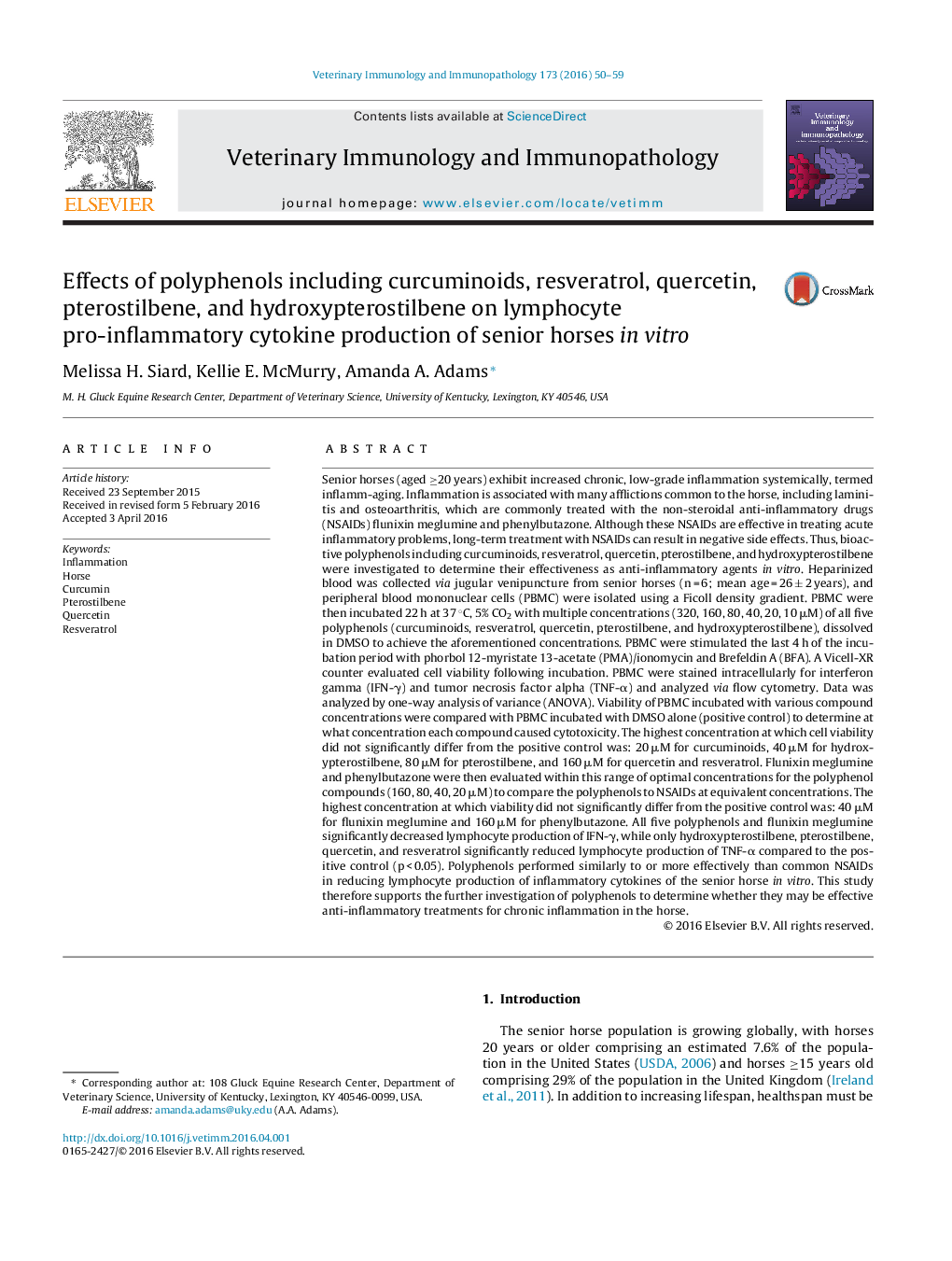| کد مقاله | کد نشریه | سال انتشار | مقاله انگلیسی | نسخه تمام متن |
|---|---|---|---|---|
| 2461319 | 1555011 | 2016 | 10 صفحه PDF | دانلود رایگان |
• Cytotoxicity and anti-inflammatory effects of 5 polyphenols were compared in vitro.
• Anti-inflammatory effects of polyphenols and NSAIDs were compared in vitro.
• All 5 polyphenols significantly decreased inflammation without becoming cytotoxic.
• Polyphenols decreased inflammation similarly to or better than NSAIDs.
Senior horses (aged ≥20 years) exhibit increased chronic, low-grade inflammation systemically, termed inflamm-aging. Inflammation is associated with many afflictions common to the horse, including laminitis and osteoarthritis, which are commonly treated with the non-steroidal anti-inflammatory drugs (NSAIDs) flunixin meglumine and phenylbutazone. Although these NSAIDs are effective in treating acute inflammatory problems, long-term treatment with NSAIDs can result in negative side effects. Thus, bioactive polyphenols including curcuminoids, resveratrol, quercetin, pterostilbene, and hydroxypterostilbene were investigated to determine their effectiveness as anti-inflammatory agents in vitro. Heparinized blood was collected via jugular venipuncture from senior horses (n = 6; mean age = 26 ± 2 years), and peripheral blood mononuclear cells (PBMC) were isolated using a Ficoll density gradient. PBMC were then incubated 22 h at 37 °C, 5% CO2 with multiple concentrations (320, 160, 80, 40, 20, 10 μM) of all five polyphenols (curcuminoids, resveratrol, quercetin, pterostilbene, and hydroxypterostilbene), dissolved in DMSO to achieve the aforementioned concentrations. PBMC were stimulated the last 4 h of the incubation period with phorbol 12-myristate 13-acetate (PMA)/ionomycin and Brefeldin A (BFA). A Vicell-XR counter evaluated cell viability following incubation. PBMC were stained intracellularly for interferon gamma (IFN-γ) and tumor necrosis factor alpha (TNF-α) and analyzed via flow cytometry. Data was analyzed by one-way analysis of variance (ANOVA). Viability of PBMC incubated with various compound concentrations were compared with PBMC incubated with DMSO alone (positive control) to determine at what concentration each compound caused cytotoxicity. The highest concentration at which cell viability did not significantly differ from the positive control was: 20 μM for curcuminoids, 40 μM for hydroxypterostilbene, 80 μM for pterostilbene, and 160 μM for quercetin and resveratrol. Flunixin meglumine and phenylbutazone were then evaluated within this range of optimal concentrations for the polyphenol compounds (160, 80, 40, 20 μM) to compare the polyphenols to NSAIDs at equivalent concentrations. The highest concentration at which viability did not significantly differ from the positive control was: 40 μM for flunixin meglumine and 160 μM for phenylbutazone. All five polyphenols and flunixin meglumine significantly decreased lymphocyte production of IFN-γ, while only hydroxypterostilbene, pterostilbene, quercetin, and resveratrol significantly reduced lymphocyte production of TNF-α compared to the positive control (p < 0.05). Polyphenols performed similarly to or more effectively than common NSAIDs in reducing lymphocyte production of inflammatory cytokines of the senior horse in vitro. This study therefore supports the further investigation of polyphenols to determine whether they may be effective anti-inflammatory treatments for chronic inflammation in the horse.
Journal: Veterinary Immunology and Immunopathology - Volume 173, May 2016, Pages 50–59
